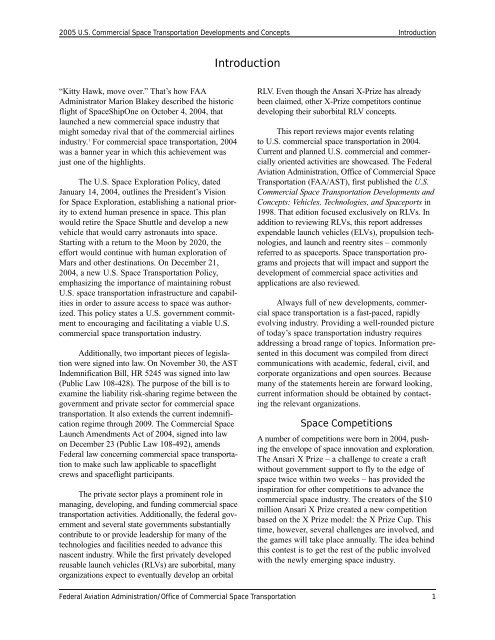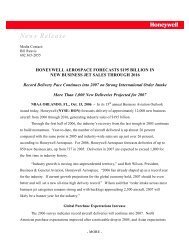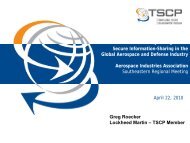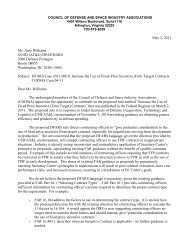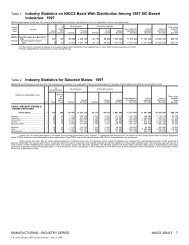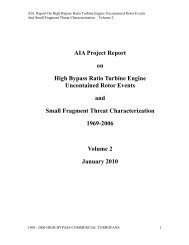Untitled - Aerospace Industries Association
Untitled - Aerospace Industries Association
Untitled - Aerospace Industries Association
Create successful ePaper yourself
Turn your PDF publications into a flip-book with our unique Google optimized e-Paper software.
2005 U.S. Commercial Space Transportation Developments and Concepts IntroductionIntroduction“Kitty Hawk, move over.” That’s how FAAAdministrator Marion Blakey described the historicflight of SpaceShipOne on October 4, 2004, thatlaunched a new commercial space industry thatmight someday rival that of the commercial airlinesindustry. 1 For commercial space transportation, 2004was a banner year in which this achievement wasjust one of the highlights.The U.S. Space Exploration Policy, datedJanuary 14, 2004, outlines the President’s Visionfor Space Exploration, establishing a national priorityto extend human presence in space. This planwould retire the Space Shuttle and develop a newvehicle that would carry astronauts into space.Starting with a return to the Moon by 2020, theeffort would continue with human exploration ofMars and other destinations. On December 21,2004, a new U.S. Space Transportation Policy,emphasizing the importance of maintaining robustU.S. space transportation infrastructure and capabilitiesin order to assure access to space was authorized.This policy states a U.S. government commitmentto encouraging and facilitating a viable U.S.commercial space transportation industry.Additionally, two important pieces of legislationwere signed into law. On November 30, the ASTIndemnification Bill, HR 5245 was signed into law(Public Law 108-428). The purpose of the bill is toexamine the liability risk-sharing regime between thegovernment and private sector for commercial spacetransportation. It also extends the current indemnificationregime through 2009. The Commercial SpaceLaunch Amendments Act of 2004, signed into lawon December 23 (Public Law 108-492), amendsFederal law concerning commercial space transportationto make such law applicable to spaceflightcrews and spaceflight participants.The private sector plays a prominent role inmanaging, developing, and funding commercial spacetransportation activities. Additionally, the federal governmentand several state governments substantiallycontribute to or provide leadership for many of thetechnologies and facilities needed to advance thisnascent industry. While the first privately developedreusable launch vehicles (RLVs) are suborbital, manyorganizations expect to eventually develop an orbitalRLV. Even though the Ansari X-Prize has alreadybeen claimed, other X-Prize competitors continuedeveloping their suborbital RLV concepts.This report reviews major events relatingto U.S. commercial space transportation in 2004.Current and planned U.S. commercial and commerciallyoriented activities are showcased. The FederalAviation Administration, Office of Commercial SpaceTransportation (FAA/AST), first published the U.S.Commercial Space Transportation Developments andConcepts: Vehicles, Technologies, and Spaceports in1998. That edition focused exclusively on RLVs. Inaddition to reviewing RLVs, this report addressesexpendable launch vehicles (ELVs), propulsion technologies,and launch and reentry sites – commonlyreferred to as spaceports. Space transportation programsand projects that will impact and support thedevelopment of commercial space activities andapplications are also reviewed.Always full of new developments, commercialspace transportation is a fast-paced, rapidlyevolving industry. Providing a well-rounded pictureof today’s space transportation industry requiresaddressing a broad range of topics. Information presentedin this document was compiled from directcommunications with academic, federal, civil, andcorporate organizations and open sources. Becausemany of the statements herein are forward looking,current information should be obtained by contactingthe relevant organizations.Space CompetitionsA number of competitions were born in 2004, pushingthe envelope of space innovation and exploration.The Ansari X Prize – a challenge to create a craftwithout government support to fly to the edge ofspace twice within two weeks – has provided theinspiration for other competitions to advance thecommercial space industry. The creators of the $10million Ansari X Prize created a new competitionbased on the X Prize model: the X Prize Cup. Thistime, however, several challenges are involved, andthe games will take place annually. The idea behindthis contest is to get the rest of the public involvedwith the newly emerging space industry.Federal Aviation Administration/Office of Commercial Space Transportation 1


